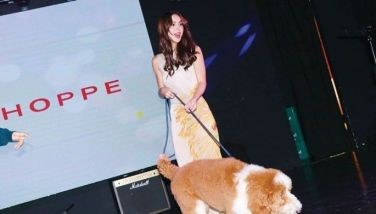Rare treat for local jazz buffs
Don’t look now but very recently, a true all-star jazz group performed at the ABS jazz night called the Philippine Jazz and Arts Festival 2011 at the Rockwell Tent, Makati City. It was a rare treat among local jazz buffs. The festival featured Mishka Adams and occasional sideman and band leader, Fil-Am saxophonist Jon Irabagon, but the act that most excited contemporary jazz fans was the Grammy-nominated group Fourplay, led by Bob James, who for almost four decades has been one of the top names in so-called rock-jazz fusion.
Fusion was a jazz genre very popular in the ’70s, and we thought then that it was a passing thing, that mainstream jazz and other jazz forms were here to stay ó but not fusion. We have several fusion LPs in our record collection (Earl Klugh, Deodato, Stanley Turrentine, Grover Washington, David Sanborn, etc.), but we dropped their music from our playlist, finding it to be too “easy-listening” and smooth.
We had the chance to talk to James and his bandmates at the Pen the afternoon before their evening performance. The three others were bassist Nathan East, drummer Harvey Mason and guitarist Chuck Loeb. The group was saying that for jazz to be alive and continually provocative, artists have to “explore the limitless dimensions and permutations of jazz while at the same time appealing to a broad mainstream audience.”
He rues that there is a lot of pressure in other directions and they are usually about giving in to the common denominator ó do the popular thing. James for all this puts emphasis on innovation and daring if the artists are to continue the spirit and the music.
James tells us his favorite jazz artists were Count Basie, Bill Evans and Oscar Peterson. He says there always has to be a new breed of dynamic artists who would add their own concepts and styles to the genre. Not get stuck in what they are doing. The music has to evolve, he says. Yes, that means moving away from the fusion of old.
And old, though somehow still gasping for life, fusion now really is. The ’70s decade was a generation ago, when today’s kids and young professionals weren’t born yet. When James shot into the jazz scene that time, the long-playing record (LP) was audiophiles’ main music source, with the CD still unheard of. That time, disco was king and rock ’n roll peaked, being the most technically proficient in rock history. The more snobbish music fans who found those two music genres too smooth and “popular” turned to fusion jazz.
Some four decades later, several fusion artists have kept the flame alive and claim to have made strides.
 Fourplay onstage: Jazz is an eternal thing. It is the common bond among people.
Fourplay onstage: Jazz is an eternal thing. It is the common bond among people. In the early ’90s, James who had had many solo albums as keyboardist, created a new group to continue the cause of contemporary jazz, mixing it in R&B, pop and other genres. He formed the band Fourplay with East, Mason and Lee Ritenour, another famous name in jazz fusion. In 1998, Larry Carlton took over Ritenour as guitarist, and recently, Loeb replaced Carlton. Thus, with either Ritenour or Loeb, Fourplay has had powerhouse personnel.
It also helped that in all those years, the group toured the United States, Europe, and Asia including China, and even South Africa, and made a dozen CDs, six of them making it to the Billboard’s Contemporary Jazz Album charts. Some of their CDs were released by Warner Bros., the most recent being Let’s Touch the Sky.
Chuck Loeb is a highly-skilled guitarist who plays any style of music but the style most associated with him through the years is so-called “contemporary” or “smooth” jazz.
As early as when he was 11, he was already playing guitar and discovered jazz at 16. Early mentors included Jim Hall, Pat Metheny and Joe Puma. He studied at the Berklee College of Music and played in New York with the likes of Hubert Laws, Chico Hamilton and Joe Farrell and then in 1979 joined Stan Getz for two years.
In New York, Loeb worked on jingles and soundtracks as player and composer. More recently, he produced recordings of other artists while some of his compositions were recorded by several pop/jazz artists. Loeb was with Petit Blonde, Metro and the Fantasy Band, and played with Gary Burton, Dave Samuels, and many others. Loeb made his first solo record in 1988, and for the next seven years released six albums. Loeb remained active in the 21st century, and now tours with Fourplay.
Harvey Mason is a respected and much sought-after busy studio musician. Like Loeb, Mason attended Berklee but graduated from the New England Conservatory. As a young drummer, Mason played in the early ’70s with Erroll Garner and George Shearing. When he moved to Los Angeles, he earned a good reputation playing in the studios, doing films and TV. Other professional involvements include Herbie Hancock’s Headhunters in 1973, Gerry Mulligan during a Carnegie Hall concert in 1974, Freddie Hubbard, Grover Washington Jr., Lee Ritenour, Victor Feldman, George Benson (he’s the one who played drums on This Masquerade) and Bob James himself.
Loeb says that nowadays, the jazz musician has bigger challenges than before and “the doors are more open now,” what with new technologies including non-musical ones like the Internet, Twitter, and the YouTube. He says, “Jazz is an eternal thing. It is the common bond among people. Fourplay has four unique voices on their own instruments. Artists have more freedom to do as they please. I want more of that.”
- Latest
- Trending
































